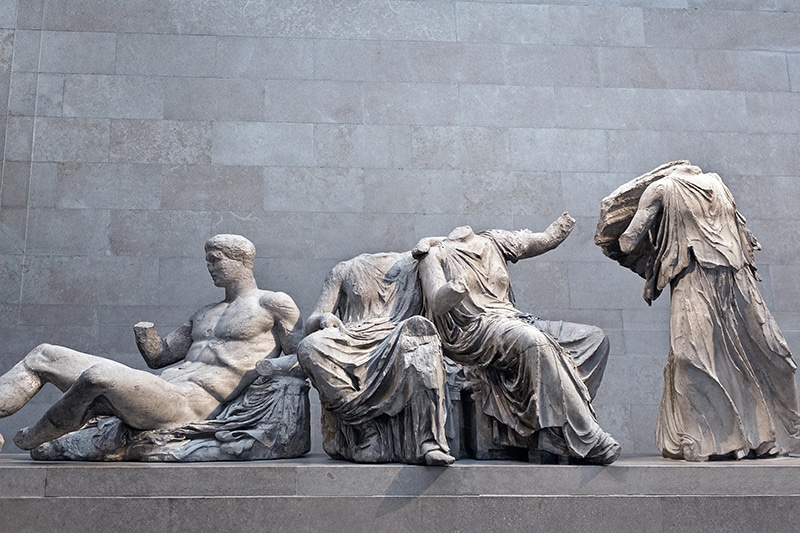At the end of August, it was reported that around 2,000 artefacts, including gold jewellery and gems, had been stolen from the British Museum over a long period of time.
Chairman of the trustees, George Osborne acknowledged that the museum’s reputation has suffered as a result of its mishandling of the thefts, which sparked outrage after it was revealed that most of the stolen antiquities may never be recovered due to the museum’s poor record keeping, raising questions about security and leadership.
For decades, the British Museum has argued that the Parthenon Marbles should not be returned to Greece since the country lacks a suitable location for their display.
The Acropolis Museum, on the other hand, has solidified its place among the world’s top ten best museums and is the go-to museum in Athens where one can readily understand why Greece is considered the cradle of Western civilization. So, why not return the Parthenon marbles to their rightful home, and how did they end up in the British Museum in the first place?
In the early 1800s, when British aristocrat Lord Elgin sailed home from Greece, he also shipped to England some of the greatest treasures of antiquity, which included a collection of Greek statues and carved frieze panels that once decorated the Parthenon in Athens.
The so-called Elgin Marbles were later sold to the British government with the approval of the Ottomans who ruled Greece at the time and became the most storied artefacts in the British Museum’s collection. They also became the subject of perhaps the world’s most notorious cultural dispute.
The British maintain that the marbles were legally acquired and they belong in a universal museum alongside other artefacts, excluding the 2,000 that were now reportedly stolen. The Greeks, on the other hand, view them as looted treasures that form the cornerstone of their national heritage.
For decades, the issue of the Parthenon Marbles has been on the agenda of the Unesco Intergovernmental Committee for Promoting the Return of Cultural Property (ICPRCP). In fact, it was Melina Mercouri, the Greek Minister of Culture at the time, who raised the matter of their return during the 1982 Unesco World Conference.
Although the forum ruled in favour of the cause, stating that restitution of works illegally removed from their countries of origin is a fundamental principle of people-to-people cultural relations, Mercouri’s British counterpart responded that the UK Government “could not intervene in the affairs of a private establishment like the British Museum.”
While efforts are underway to retrieve the stolen antiquities, the British Museum’s collections may never be recovered because the museum’s records only identify the collection as a whole and fail to list the individual pieces.
This is not the first time the museum’s image as a safe keeper of global treasures has been called into doubt. The poor condition of the British Museum’s western block has been recorded numerous times. Images of water leaking into the Parthenon gallery were broadcast on Greek television in 2018, resulting from a cracked glass ceiling pane. Although the glass was replaced with new fixings and no sculptures were destroyed, a leaking roof in 2021 resulted in water seeping through, once again, delaying the reopening of the Greek galleries following the pandemic.
The British Museum claimed that none of the statues had been damaged and the issue was addressed. However, for Greece, these events demonstrate that the British Museum is failing to care for the Parthenon Marbles, reinforcing the country’s legitimate claim that the sculptures be permanently returned to Athens.
Earlier this year, the British Museum moved closer to a landmark agreement with Athens that could result in the return of the marbles. Although existing legislation makes it illegal to give away treasures, Osborne is reportedly seeking to repatriate the Parthenon Marbles as part of a cultural exchange that would see other Greek antiques displayed at the British Museum. Over half of the British people support their repatriation to Greece.
Hundreds of statues from the Archaic and Classical periods can be found at the ultramodern Acropolis Museum. The top level is the museum’s showcase, which provides a visual link to the Acropolis and allows visitors to view both the monument and its sculptures. The majority of the Parthenon Marbles will be displayed there upon their anticipated return.
The Parthenon Sculptures were made in Greece by Greeks to honour the glory of Greece. They represent millions of people’s cultural identities. Greece is their true home. It is where they belong.







Click here to change your cookie preferences